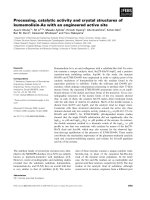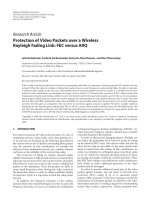Electrochemical syntheses and self assembly of nanostructure as modified electrodes for polythiophene preparation
Bạn đang xem bản rút gọn của tài liệu. Xem và tải ngay bản đầy đủ của tài liệu tại đây (2.89 MB, 247 trang )
ELECTROCHEMICALSYNTHESESAND
SELF-ASSEMBLYOFNANOSTRUCTUREAS
MODIFIEDELECTRODESFORPOLYTHIOPHENE
PREPARATION
ZHANGCHUNYAN
NATIONALUNIVERSITYOFSINGAPORE
2002
ELECTROCHEMICALSYNTHESESAND
SELF-ASSEMBLYOFNANOSTRUCTUREAS
MODIFIEDELECTRODESFORPOLYTHIOPHENE
PREPARATION
ZHANGCHUNYAN
(B.Sc.NanjingUniversityofP.R.China)
ATHESISSUBMITTED
FORDOCTOROFPHILOSOPHY
DEPARTMENTOFCHEMISTRY
NATIONALUNIVERSITYOFSINGAPORE
2002
i
Acknowledgments
Iwouldliketoexpressmygreatestappreciationtomysupervisors,Professor
Hardy,S.O.ChanandAssociateProfessorNgSiuChoonforprovidingthisop-
portunityformyacademicpursuitandfortheirgreathelpandvaluableguidance
throughouttheyears.
MyheartfeltthanksmustgotoallthecolleaguesintheFunctionalPolymer
Laboratory,NUSfortheircontinuoushelpandencouragement.Specialthanksto
Dr.MiaoPingandDr.Richard,SeowSweeHowfortheirkindnessinproviding
bithiophenederivativesformyresearchandtheirvaluableadvice,Dr.Chen
Zhikuan,Dr.DouZeling,HanYanhuiandFuPingfortheirassistanceinlablife,
OngTengTeng,XuLingge,ChenDizhong,SunTong,XuJinmei,LuHongfang,
MaYifei,WongYeongChingandmanyothersfortheirhelpandaccompany.
Iwouldalsoliketothankthesta®ofCentralInstrumentalLab,ChemicalStore
inChemistryDepartmentfortheirassistanceduringthisproject.Manythanks
toPhysicsDepartment,MaterialScienceDepartmentandBiologyDepartment
inusingAFM,SEMandTEMinstruments.SpecialthankstoMr.WongHow
KwongfromPhysicsDepartmentfordoingtheXPSanalysis.
Finally,Iwishtoexpressmygratitudetomyparentsfortheirconstantcaring
ii
andsupportthroughoutmylife.SpecialthanksgotomyhusbandZouYufor
hissupportandhelpinmythesisediting.
ZhangChunyan
2002
iii
Contents
Acknowledgmentsi
Contentsiii
ListofFiguresx
ListofTablesxix
Abbreviationsxxi
Summaryxxiv
Chapter1.Introduction1
1.1IntroductiontoConductingPolymers 1
1.2ConductionMechanism 2
1.2.1BandTheory 3
1.2.2PolaronandBipolaronModel 4
1.2.3ConductivityofConductingPolymers 6
1.3ChemistryofPolythiophenes 7
1.3.1FunctionalizationofPolythiophenes 8
1.3.2ChemicalSynthesesofPolythiophenes 10
1.3.3ElectrochemicalSynthesesofPolythiophenes 10
1.3.4FactorsinElectrochemicalPolymerization 12
1.4PropertiesofPolythiophenes 13
1.4.1ElectrochemicalPropertiesofPolythiophenes 13
iv
1.4.2SpectroscopicPropertiesofPolythiophenes-UV-vis-NIR
Spectroscopy 16
1.4.3ChemicalEnvironmentofElements-X-rayPhotoelectron
Spectroscopy 18
1.5Self-assemblyofPolythiophenes 19
1.6ABridge:ConductingPolymersandMetalNanoparticles 21
1.7AnIntroductiontoMetalNanoparticle 22
1.7.1HistoricPerspectiveofGoldNanoparticles 22
1.7.2BandStructureofNobleMetalNanoparticles 23
1.7.3StabilizationMethodsofMetalNanoparticles 24
1.8PreparativeMethodsofMetalNanoparticles 26
1.8.1SolutionPhaseSaltReduction 26
1.8.2Brust'sMethodandIt'sApplications 27
1.9PropertiesandCharacterizationofMetalNanoparticles 29
1.9.1SolubilityofMetalNanoparticles 31
1.9.2SizeandShapeofNanoparticles 31
1.9.3UV-VisibleSpectroscopy 31
1.9.4X-RayPhotoelectronSpectroscopy(XPS) 34
1.9.5TransmissionElectronMicroscopy(TEM) 35
1.9.6AtomicForceMicroscopy(AFM) 36
1.9.7Electrochemistry:CyclicVoltammetry(CV)andDi®eren-
tialPulseVoltammetry(DPV) 37
1.10ScopeofDissertation 38
Chapter2.ElectrochemicalSynthesesofPolybithiopheneDeriva-
tivesUsingBF
3
¢OEt
2
asElectrolyte41
2.1Introduction 41
2.2Experimental 43
v
2.2.1Monomers 43
2.2.2DeterminationofMonomerOxidationpotential 45
2.2.3DeterminationofPolymerOxidationPotential 45
2.3ResultsandDiscussion 45
2.3.1ElectrochemicallyPolymerizationofMono-substitutedBithio-
phenes 46
2.3.2ElectrochemicalPolymerizationofBithiopheneswithAl-
ternateElectron-donatingandElectron-withdrawingGroups53
2.3.3ElectrochemicallyPolymerizationofSymmetricallyDi-substituted
Bithiophenes 56
2.4Summary 64
Chapter3.PropertiesofBF
3
¢OEt
2
DopedPolybithiopheneDeriv-
atives66
3.1Introduction 66
3.2Experimental 67
3.2.1PreparationofPolymers 67
3.2.2Ultraviolet-visibleAbsorptionSpectroscopy 67
3.2.3X-rayPhotoelectronSpectroscopy 68
3.3ResultsandDiscussion 68
3.3.1ElectrochemicalAnalysisofPolymers 68
3.3.2ElectrolyteintheElectrochemicalSynthesesandElectro-
chemicalPropertiesofHalogenSymmetricallyDisubstituted
Polybithiophenes 80
3.3.3OpticalPropertiesofResultingPolymers 82
3.3.4XPSStudyofPolymersPreparedfromBF
3
¢OEt
2
88
3.4Summary 94
vi
Chapter4.ThienylthiolateModi¯edPolycrystallineAuElectrode
forElectrochemicalPolymerizationofSubstitutedBithiophenes95
4.1Introduction 95
4.2Experimental 97
4.2.1Self-AssembledThienylthiolateMonolayeronPolycrystalline
AuElectrode 97
4.2.2ElectrochemicalPolymerizationonModi¯edElectrode 98
4.3ResultsandDiscussions 99
4.3.1FormationofSelf-AssembledThienylthiolateMonolayeron
AuElectrode 99
4.3.2MonolayerCharacterizationbyXPS 100
4.3.3CyclicVoltammetryofFerrocyanideonChemisorbedMono-
layerModi¯edAuElectrode 102
4.3.4AtomicForceMicroscopyofChemisorbedMonolayer 103
4.3.5ElectrochemicalPolymerizationofBithiophenesonThienylth-
iolateMonolayerModi¯edAuElectrode 105
4.3.6CVofPolymer-coatedElectrodeRinsedbyOrganicSolvent109
4.4Summary 113
Chapter5.MicroelectrodeofSelf-AssembledAqueousAuNanopar-
ticlesonITOGlassforElectrochemicalPolymerizationofBithio-
phene114
5.1Introduction 114
5.2Experimental 115
5.3ResultsandDiscussion 116
5.3.1Self-assemblyofAqueousAuNanoparticlesonSilanized
ITOGlassElectrode 116
vii
5.3.2ElectrochemistryofVariousModi¯edElectrodes 117
5.3.3UV-visSpectroscopyinCharacterizationofSurfaceModi-
¯cation 119
5.3.4SurfaceMorphologyofModi¯edSurfaces 121
5.3.5XPSStudyinModi¯edSurfaces 124
5.3.6ElectrochemistryofPBTSynthesizedonVariousElectrodes126
5.3.7SpectroscopicPropertiesofPBTSynthesizedonVarious
Electrodes 127
5.3.8XPSstudyinPBTPreparedonModi¯edElectrode 128
5.4Summary 131
Chapter6.ThienylthiolatesMonolayerProtectedGoldNanopar-
ticles132
6.1Introduction 132
6.2Experimental 133
6.2.1SynthesesofThienylthiolatesasStabilizationLigands 133
6.2.2PreparationofGoldNanoparticleswithStabilizationLigands134
6.3ResultsandDiscussions 135
6.3.1MonolayerProtectedGoldNanoparticle 135
6.3.2Solubility 138
6.3.3ParticleSizeandDistribution 138
6.3.4Composition 144
6.3.5SpectroscopicProperties 148
6.4Summary 151
Chapter7.CoulombStaircaseFeatureofThienylthiolate-Stabilized
AuNanoparticles152
7.1Introduction 152
7.1.1Background 152
viii
7.1.2MetalNanoparticlesasBuildingBlocks 153
7.1.3CoulombStaircase 153
7.1.4SolutionEnsembleCoulombStaircase 156
7.2Experimental 158
7.3ResultsandDiscussions 159
7.3.1CVandDPVofThienylthiolateStabilizedGoldNanopar-
ticles 159
7.3.2SolventE®ectinQuantizedDoubleLayerCharging 162
7.4Summary 165
Chapter8.ElectrochemicalPolymerizationofBithiophenesIncor-
poratingThienylthiolateStabilizedAuNanoparticles166
8.1Introduction 166
8.2Experimental 167
8.3ResultsandDiscussions 168
8.3.1Self-assemblyofNonaqueousAuColloidonsilanizedITO
GlassElectrode 168
8.3.2ElectrochemicalPolymerizationofBithiophenesinaSolu-
tionContainingThienylthiolateStabilizedAuNanoparticles175
8.3.3PropertiesofPolybithiophenesIncorporatedwithAuNanopar-
ticles 177
8.4Summary 183
Chapter9.ConclusionandFutureWork185
9.1Conclusion 185
9.2ScopeforFutureWork 186
Chapter10.ExperimentalSection188
10.1Instrumentation 188
ix
10.2Chemicals 191
10.3Syntheses 191
10.3.1PreparationofThienylThiols 191
10.3.2ElectrochemicalPolymerization 194
10.3.3PreparationofColloidalGoldNanoparticles 194
10.3.4ElectrodeModi¯cation 195
Bibliography197
x
ListofFigures
1.1Illustrationofenergybandstructuresofmaterials.VB:valence
band,CB:conductionband 3
1.2Polaronandbipolaronstructuresofpolythiophene 5
1.3Aromaticandquinoidstructuresofthiophene 5
1.4Formationofmid-gapstatesofpolaronorbipolaronuponp-doping.6
1.5Structuresof3or4positionfunctionalizedoligothiophenes 8
1.6Structuresofthiopheneswithconjugatedspacer 9
1.7Structuresofthiopheneswithfusedringfunctionalization 9
1.8Structureofsymmetricallydisubstitutedoligothiophene 10
1.9Reactionmechanismofanodicpolymerizationofthiophene 12
1.10CVofp-dopeofPBRHEBTin0.1Mmonomerfree(A)Bu
4
NBF
4
/CH
3
CN
and(B)BF
3
¢OEt
2
,scanrate:50mVs
¡1
14
1.11Illustrationofenergybandstructuretransitionbetweenbulkmetal
andmolecularclusters 24
1.12Electrostaticstabilizationofmetalcolloidparticles 25
1.13Stericstabilizationofmetalcolloidparticlesbypolymersorsur-
factantmolecules 26
xi
1.14ExamplesofthiolligandsusedtoprepareMPCs:(a)straight
chainalkanethiols;(b)glutanthione;(c)tiopronin;(d)thiolated
poly(tethyleneglycol);(e)p-mercaptophenol;(f)aromaticalka-
nethiol;(g)phenylalkanethiols;(h)(°-mercaptopropyl)-trimethoxysilane.30
1.15SketchofDOSforAu:(A)bulkAu;(B)verylargeAuclusters;
(C)verysmallAuclusters 32
1.16UV-Visspectrumofasampleof » 13nmAunanoparticlespre-
paredfromcitratereductioninourlab 34
1.17(A)HeightAFMimageand(B)TEMimageof3-mercapto-2,2'-
bithiophenestabilizedgoldnanoparticles(preparedinourlab) 37
2.1Mono-substituted2,2'-bithiophenes 44
2.2Dissymmetricallydisubstituted2,2'-bithiophenes 44
2.3Symmetricallydisubstituted2,2'-bithiophenes 44
2.4Polymerizationof3OCBTinBu
4
NBF
4
/CH
3
CN.0.05Mmonomer,
scanrate:50mVs
¡1
47
2.5Polymerizationof(a)3OMEBTand(b)3BRBTinBF
3
¢OEt
2
.0.05
Mmonomer,scanrate:50mVs
¡1
51
2.6Polymerizationof0.05M(a)BT,(b)3OMEBT,(c)3OCBTand
(d)3BRBTbyCEmethodsat0.2mAcm
¡2
inBF
3
¢OEt
2
52
2.7Polymerizationof0.05MBRHEBTbyCEmethodsat0.2mA
cm
¡2
in(a)BF
3
¢OEt
2
and(b)Bu
4
NBF
4
/CH
3
CN 54
2.8PolymerizationofBRHEBTin(A)BF
3
¢OEt
2
and(B)Bu
4
NBF
4
/CH
3
CN.
0.05Mmonomer,scanrate:50mVs
¡1
55
xii
2.9Polymerizationof(A)DBRBTand(B)DIBTinBF
3
¢OEt
2
,0.01-
0.05Mmonomer,scanrate:50mVs
¡1
58
2.10Polymerizationof(a)DCLBT,(b)DBRBTand(c)DIBTbyCE
methodsat0.1mAcm
¡2
inBF
3
¢OEt
2
,0.01-0.05Mmonomer 60
2.11Polymerizationof(a)DOCBT,(b)DSOCBTand(c)DOBUBT
inBF
3
¢OEt
2
,0.05Mmonomer,scanrate:50mVs
¡1
62
2.12Polymerizationof0.05M(a)DOCBT,(b)DSOCBTand(c)DOBUBT
byCEmethodsat0.2mAcm
¡2
inBF
3
¢Et
2
64
3.1CVofp-dopeof(a)P3OCBTand(b)P3OMEBTad(c)P3BRBT
inmonomerfreeBF
3
¢OEt
2
,scanrate:50mVs
¡1
71
3.2The¯rst10CVcyclesof(a)P3OCBTand(b)P3OMEBTand(c)
P3BRBTinmonomerfreeBF
3
¢OEt
2
,scanrate:50mVs
¡1
73
3.3CVofp-dopeofPBRHEBTinmonomerfree(A)BF
3
¢OEt
2
and
(B)0.1MBu
4
NBF
4
/CH
3
CN,scanrate:50mVs
¡1
74
3.4CVofn-dopeofPBRHEBT(preparedfromBu
4
NBF
4
/CH
3
CN)in
0.1MmonomerfreeBu
4
NBF
4
/CH
3
CN,scanrate:50mVs
¡1
75
3.5CVofp-andn-dopeofPBRHEBTin0.1MmonomerfreeBu
4
NBF
4
/CH
3
CN,
scanrate:50mVs
¡1
76
3.6CVofp-dopeof(A)PDCLBT,(B)PDBRBTand(C)PDIBTin
monomerfreeBF
3
¢OEt
2
,scanrate:50mVs
¡1
78
3.7CVofp-dopeof(a)PDOCBTand(b)PDSOCBTinmonomer
freeBF
3
¢OEt
2
,scanrate:50mVs
¡1
79
xiii
3.8CVofp-dopeofPDBRBTprepared(a)fromBF
3
¢OEt
2
inmonomer
freeBF
3
¢OEt
2
,(b)from0.05MBu
4
NBF
4
/CH
3
CNin0.1Mmonomer
freeBu
4
NBF
4
/CH
3
CNand(c)from0.05MBu
4
NBF
4
/CH
3
CNin
monomerfreeBF
3
¢OEt
2
,scanrate:50mVs
¡1
81
3.9CVofp-dopeofPDIBTprepared(a)fromBF
3
¢OEt
2
inmonomer
freeBF
3
¢OEt
2
and(c)from0.05MBu
4
NBF
4
/CH
3
CNinmonomer
freeBF
3
¢OEt
2
,scanrate:50mVs
¡1
82
3.10UV-vis-NIRspectraof(A)PBT,(B)P3OCBT,(C)P3OMEBT
and(D)P3BRBTin(a)dedopedand(b)dopedstateinBF
3
¢OEt
2
.85
3.11UV-vis-NIRspectraof(A)PDCLBT,(B)PDBRBTand(C)PDIBT
in(a)dedopedand(b)dopedstatebyBF
3
¢OEt
2
87
3.12XPSspectraofC(1s)andS(2p)of(A)BF
3
dopedPBT,(B)de-
dopedPBTpreparedfromelectrosynthesisinBF
3
¢OEt
2
90
3.13XPSspectraofC(1s)andS(2p)of(A)BF
¡
4
dopedPBT,(B)de-
dopedPBTpreparedfromelectrosynthesisinBu
4
NBF
4
/CH
3
CN.91
3.14XPSspectraofF(1s)of(A)BF
3
dopedPBT,(B)BF
¡
4
dopedPBT,
(C)dedopedPBTpreparedinBF
3
¢OEt
2
and(D)BF
3
redoped
PBTpreparedinBu
4
NBF
4
/CH
3
CN 93
4.1Structureof5SHBTandmonomersforelectrochemicalpolymer-
ization 98
4.2Schematicillustrationofsurfaceorientationof5SHBTmonolayer
onAuelectrode 99
4.3S(2p)andAu(4f)spectraof5SHBTmonolayeronAuelectrode 101
xiv
4.4Voltametricresponseof5.0mMFe(CN)
4+
6
in0.5MNa
2
SO
4
aque-
oussolutionon(a)bareAuelectrode,5SBTmonolayercovered
Auelectrodefor(b)¯rstand(c)50thatscanrateof50mVs
¡1
103
4.53DheightAFMimagesof(A)5SHBTmonolayermodi¯edand(B)
baregoldmirrorsurface 104
4.62DphaseAFMimagesof(A)5SHBTmonolayermodi¯edand(B)
baregoldmirrorsurface 105
4.7CEforpolymerizationof3OCTonthe(a)5SHBTmodi¯edand
(b)unmodi¯edAuelectrodesurfacein0.05MBu
4
NBF
4
/CH
3
CN.106
4.8CEforpolymerizationofBTonthe(a)5SHBTmodi¯edand(b)
unmodi¯edAuelectrodesurfacein0.05MBu
4
NBF
4
/CH
3
CN 107
4.9CEforpolymerizationofDOBUBTonthe(a)5SHBTmodi¯ed
and(b)unmodi¯edAuelectrodesurfacein0.05MBu
4
NBF
4
/CH
3
CN.108
4.10CEforpolymerizationofDSOCBTonthe(a)5SHBTmodi¯edand
(b)unmodi¯edAuelectrodesurfacein0.05MBu
4
NBF
4
/CH
3
CN.109
4.11CEforpolymerizationofDBRBTonthe(a)5SHBTmodi¯edand
(b)unmodi¯edAuelectrodesurfacein0.05MBu
4
NBF
4
/CH
3
CN.110
4.12CyclicVoltammetryofPBTdepositedon(a)5SBTmonolayer
coveredAuelectrode,(b)bareAuelectrodeafterrinsinginTHF
in0.1MBu
4
NBF
4
/CH
3
CNatscanrateof50mVs
¡1
111
4.13CyclicVoltammetryofPDBRBTdepositedon(a)5SBTmono-
layercoveredAuelectrode,(b)bareAuelectrodeafterrinsingin
THFin0.1MBu
4
NBF
4
/CH
3
CNatscanrateof50mVs
¡1
112
xv
5.1Schematicdiagramofself-assembledAunanoparticlesontosilanized
ITOglasselectrodeandsubsequentself-assemblyof5SHBTmole-
cules(A: !-aminopropyl-triethoylsilane;B:5SHBT) 117
5.2Voltametricresponseof5.0mMFe(CN)
4+
6
in0.5MNa
2
SO
4
aque-
oussolutionon(a)ITO,(b)ITOSAand(c)ITOSASBTatscan
rateof50mVs
¡1
118
5.3CVof(a)ITO,(b)ITOSAand(c)ITOSASBTin0.1MBu
4
NBF
4
/CH
3
CN
atscanrateof50mVs
¡1
.Insertedisthatofpolycrystallinegold
electrode 119
5.4UV-visspectraofaqueousgoldnanoparticlesadsorbedonsilanized
ITOglasselectrodebydi®erentimmersiontime 120
5.5UV-visabsorbanceofaqueousgoldnanoparticlesadsorbedonsilanized
ITOglasselectrodeindi®erentdippingtimeframe 121
5.62DheightAFMimagesof(A)ITO,(B)ITOS,(C)ITOSAand
(D)ITOSASBTsurfaces 122
5.72DphaseAFMimagesof(A)ITO,(B)ITOS,(C)ITOSAand(D)
ITOSASBTsurfaces 123
5.8S(2p)spectrumofITOSASBTsurfaces 124
5.9Au(4f)spectraof(A)ITOSAand(B)ITOSASBTsurfaces 125
5.10CVsofPBTdepositedon(a)ITO,(b)ITOSAand(c)ITOSASBT
in0.1MBu
4
NBF
4
/CH
3
CNatscanrateof50mVs
¡1
127
5.11UV-visspectraofPBTdepositedon(a)ITO,(b)ITOSAand(c)
ITOSASBTin0.1MBu
4
NBF
4
/CH
3
CN 128
5.12C(1s),S(2p)andAu(4f)spectraofPBTobtainedon(A)ITOSA
and(B)ITOSASBTsurfaces 130
xvi
6.1Structuresofthienylthiolatecompounds 134
6.2Schematicillustrationofthienylthiolatemonolayerprotectedgold
nanoparticle 137
6.3(A)TEMand(B)AFMheightimagesofAUSSBTnanoparticles.140
6.4(A)TEMand(B)AFMheightimagesofAURSBTnanoparticles.141
6.5(A)TEMand(B)AFMheightimagesofAU5SBTnanoparticles.142
6.6(A)TEMand(B)AFMheightimagesofAU3SBTnanoparticles.142
6.7TEMImagesofAUBRSBTnanoparticleswithasurfactant-metal
feedingratioof(A)1:1,(b)1:2,(C)2:1and(D)5:1 143
6.8XPSspectraofC(1s),Au(4f)andS(2p)ofAUBRSBTcastingon
ITOglass 146
6.9Au(4f)spectraof(A)AU3SBT,(B)AU5SBT,(C)AURSBTand
(D)AUSSBT 147
6.10UVspectraof(a)AU3SBT,(b)AURSBT,(c)AU5SBT,(d)AUSSBT
and(e)AUBRSBTintoluenesolution 149
6.11UVspectraofAUBRSBTpreparedwith(a)2:1,(b)1:1,(c)1:2
and(d)1:5BRSHBTtogoldmoleratio 149
6.12UVabsorptionspectraofsolid-stateAUSSBTafterannealingbe-
tween20
±
Cand240
±
C 151
7.1SchematicSTMdoubletunnel-junctionmodel 154
7.2Current(I)inresponsetoanappliedpotentialdi®erence(V
ap
)for
a1DarrayofclustersexhibitingCoulombstaircasebehavior. V
T
isthethresholdvoltagerequiredtoachieveconduction 156
xvii
7.3SchematiceelctrochemcalensemleCoulombstaircasemodel. R
ct
is
charge-transferreistance, C
DL
isdoublelayercapacitanceand Z
W
isdi®usional(Warburg)impedanceforclusterstransportthrough
thesolution 157
7.4CyclicVoltammetryof(A)AU3SBT,(B)AU5SBT,(C)AUSSBT
and(D)AURSBTin0.1moll
¡1
Bu
4
NBF
4
co-solvent(1:1v:v)of
tolueneandPhCN.Three-electrodecellwithPtdiscelectrode(0.5
cm
2
)asworkingelectrode,PtwireascounterelectrodeandSCE
asreferenceelectrode,scanrate:10mVS
¡1
160
7.5Di®erentialPulseVoltammetryof(A)AU3SBT,(B)AU5SBT,(C)
AUSSBTand(D)AURSBTin0.1moll
¡1
Bu
4
NBF
4
co-solvent(1:1
v:v)oftolueneandPhCN.scanrate:10mVS
¡1
,pulseheight:50
mV,pulsewidth:50ms,pulseperiod:500ms 161
7.6CyclicVoltammetryofAUSSBTin0.1moll
¡1
Bu
4
NBF
4
inco-
solvent(1:1v:v)oftolueneand(A)CH
2
Cl
2
,(B)MeCN,(C)PhCN
and(D)PhNO
2
,scanrate:10mVS
¡1
163
7.7Di®erentialPulseVoltammetry(DPV)ofAUSSBTin0.1moll
¡1
Bu
4
NBF
4
inco-solvent(1:1v:v)oftolueneand(A)CH
2
Cl
2
,(B)
MeCN,(C)PhCNand(D)PhNO
2
,scanrate:10mVS
¡1
,pulse
height:50mV,pulsewidth:50ms,pulseperiod:500ms 164
7.8DiagramshowingtheproposedarrangementofSSBTadsorbedon
thesurfaceofgoldcluster 165
xviii
8.1UV-visspectraofnonaqueousgoldnanoparticles(A)AUSSBT,
(B)AURSBT,(C)AU3SBTand(D)Au5SBTadsorbedonsilanized
ITOglasselectrode 169
8.2AFM(A)2Dphaseimageand(B)3Dphaseimageofself-assembled
SSBTstabilizedAunanoparticlesonITOglass 170
8.3SEMimageofself-assembledSSBTstabilizedAunanoparticleson
ITOglass 171
8.4CyclicVoltammetryof(a)SSBTAUmodi¯edITOglasselectrode
and(b)bareITOglasselectrodein0.1MBu
4
NBF
4
/CH
3
CNso-
lution.ScanRate:50mVS
¡1
.Inserted:CVofbareAuelectrode
in0.1MBu
4
NBF
4
/CH
3
CNsolution 173
8.5PBTpreparationbyCVinamixtureof1:10.1MBu
4
NBF
4
/PhCN
andAUSSBTtoluenesolution,scanrate:50mVS
¡1
176
8.6PBTpreparationbyCEinamixtureof1:10.1MBu
4
NBF
4
/PhCN
andAUSSBTtoluenesolution,currentdensity:1mAcm
¡2
177
8.7CyclicVoltammtryofPBTpreparedinamixtureof1:10.1M
Bu
4
NBF
4
/PhCNandtolulenesolutionof(A)AUSSBT,(B)AURSBT,
(C)AU3SBTand(D)AU5SBTonPtelectrodebyCV,scanrate:
20mVS
¡1
178
8.8UV-visspectraofPBTpreparedinamixtureof1:10.1MBu
4
NBF
4
/PhCN
andgoldtoluenesolutionwithsurfactant(A)SSBT,(B)RSBT,
(C)3SBTand(D)5SBTonITOglasselectrodebyCE(1mAcm
¡2
).180
8.9C(1s),S(2p)andAu(4f)XPSspectraofPBT-AUSSBT 182
xix
ListofTables
1.1P-dopingofpolythiophenes¯lmspreparedonplatinumfoil 17
1.2Bindingenergyofdi®erentgoldspecies 35
2.1Electrochemicalpropertiesofmonomers 49
3.1Electrochemicalpropertiesofpolymers 70
3.2UV-visabsorptionofpolymers 84
3.3SurfaceelementsofPBTdopedbyBF
3
andBF
¡
4
90
4.1Bindingenergyofdi®erentsulfurspeciesin5SHBTmonolayeron
Auelectrode 102
5.1SurfacestoichiometryofPBTobtainedonITOSAandITOSASBT
electrodes 129
6.1Particlesizeandsizedistributionofvariousgoldnanoparticles 139
6.2Au(4f)
7=2
spectraofvariousthienylthiolatestabilizedgoldnanopar-
ticles 145
7.1CapacitanceofindividualparticlescalculatedfromCVandDPV.162
8.1PropertiesofPBTincorporatedwithvariousgoldnanoparticles 181
8.2Au(4f)spectraofPBTincorporatedwithvariousthienylthiolate
stabilizedgoldnanoparticles 183
xx
10.1Sensitivityfactors(f)ofelements 189
xxi
Abbreviations
CV: CyclicVoltammetry
DPV: Di®erentialPulseVoltammetry
CE: Chronopotentiometry
CA: Chronoamperometry
UV-vis: UltraVioletandVisibleSpectroscopy
XPS: X-RayPhotoelectronSpectroscopy
TEM: TransmissionElectronMicroscopy
AFM: AtomicForceMicroscopy
NMR: NuclearMagneticResonance
FE-SEM: FieldElectron-ScanningElectronMicroscopy
FT-IR: FourierTransformInfraredSpectroscopy
SAM: SelfAssembledMonolayer
SCE: SaturatedCalomelElectrode
FWHM: FullWidthatHalfMaximum
SET: SingleElectronTransfer
E
g
: BandGapEnergy
E
on
: OnsetPotential
E
pa
: OxidationPotential
E
pc
: ReductionPotential
I
pa
: AnodicPeakCurrent
I
pc
: CathodicPeakCurrent
E
f
: EnergyatFermiLevel
D
n
: NumberAverageDiameterofParticles
D
w
: WeightAverageDiameterofParticles
xxii
3OCT: 3-octyl-thiophene
BT: 2,2'-bithiophene
3OMEBT: 3-methoxy-2,2'-bithiophene
3OCBT: 3-octyl-2,2'-bithiophene
3BRBT: 3-bromo-2,2'-bithiophene
3SOCBT: 3-octylthio-2,2'-bithiophene
DOCBT: 3,3'-dioctyl-2,2'-bithiophene
DOBUBT: 3,3'-dibutoxy-2,2'-bithiophene
DSOCBT: 3,3'-dioctylthio-2,2'-bithiophene
DCLBT: 3,3'-dichloro-2,2'-bithiophene
DBRBT: 3,3'-dibromo-2,2'-bithiophene
DIBT: 3,3'-diiodo-2,2'-bithiophene
BRHEBT: 3-bromo-3'-hexyl-2,2'-bithiophene
BRSOCBT: 3-bromo-3'-octylthio-2,2'-bithiophene
3SHBT: Dithieno[3,2-c:2',3'-e][1,2]dithiin
3SHBT: 3-mercapto-2,2'-bithiophene
5SHBT: 5-mercapto-2,2'-bithiophene
RSHBT: 3-mercapto,3'-octyl-2,2'-bithiophene
RSBRBT: 3-bromo-3'-octylthio-2,2'-bithiophene
P3OMEBT: Poly(3-methoxy-2,2'-bithiophene)
P3OCBT: Poly(3-octyl-2,2'-bithiophene)
P3BRBT: Poly(3-bromo-2,2'-bithiophene)
P3SOCBT: Poly(3-octylthio-2,2'-bithiophene)
PDOCBT: Poly(3,3'-dioctyl-2,2'-bithiophene)
PDOBUBT: Poly(3,3'-dibutoxy-2,2'-bithiophene)
PDSOCBT: Poly(3,3'-dioctylthio-2,2'-bithiophene)
PDCLBT: Poly(3,3'-dichloro-2,2'-bithiophene)
PDBRBT: Poly(3,3'-dibromo-2,2'-bithiophene)
PDIBT: Poly(3,3'-diiodo-2,2'-bithiophene)
PBRHEBT: Poly(3-bromo-3'-hexyl-2,2'-bithiophene)
AUSSBT: Dithieno[3,2-c:2',3'-e][1,2]dithiinStabilizedAuNanoparticle
AU3SBT: 3-mercapto-2,2'-bithiopheneStabilizedAuNanoparticle
AU5SBT: 5-mercapto-2,2'-bithiopheneStabilizedAuNanoparticle
xxiii
AURSBT: 3-mercapto,3'-octyl-2,2'-bithiopheneStabilizedAuNanoparticle
AUBRSBT: StabilizedAuNanoparticle



![Báo cáo khoa học: Properties and significance of apoFNR as a second form of air-inactivated [4Fe-4S]ÆFNR of Escherichia coli pot](https://media.store123doc.com/images/document/14/rc/at/medium_ata1395562826.jpg)





